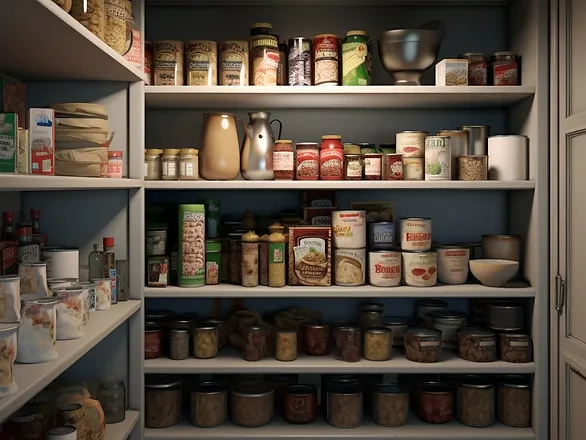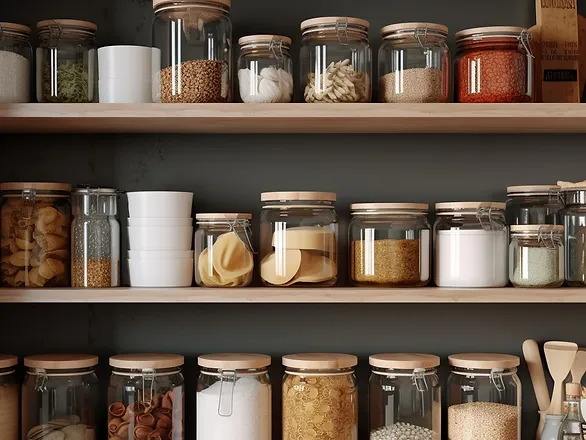Looking to organize your pantry on a budget? Discover easy and affordable tips to turn your pantry chaos into a neatly organized haven. Learn how to use simple items for clever storage and get creative with what you already have at home. Ready for a pantry transformation that won’t empty your wallet? I’m going to share practical, money-saving organizing ideas for you to start your journey to a clutter-free pantry today!

This site contains affiliate links, please view the disclosure for more information.
Let’s talk about something we all deal with every day: the pantry. It’s like a secret world in our homes, filled with snacks, spices, and sometimes a bit of chaos. Today, let’s take a walk through organizing and making the most out of our pantries.
The Heart of the Home: Your Pantry
Our pantry is more than just a place to store food. It’s where we go to plan meals, grab snacks for the kids, and sometimes, it’s where we sneak a little treat for ourselves. It’s the heart of our home’s kitchen. But let’s be real, keeping it organized can feel like a huge task.
Organizing Made Simple
Organizing your pantry doesn’t have to be a big, scary project. Start with small steps. Take everything out and see what you have. It’s like a treasure hunt! You might find things you forgot about. Group similar items together – all the pastas in one spot, snacks in another. This makes it easier to find what you need and keeps your pantry tidy.
Kid-Friendly Zones
If you have little ones, create a kid-friendly zone in your pantry. Put their favorite snacks and cereals on shelves they can reach. This helps them be more independent and lets you catch a break from fetching snacks every five minutes. It’s a win-win!
Meal Planning Magic
Having an organized pantry helps with meal planning. You can see what you have and what you need to buy. This saves money and time. Plan your meals around what’s already in your pantry. It’s like a puzzle, fitting everything together to make yummy meals for your family.
The Joy of Jar Labels
Let’s talk about jars and labels. They aren’t just pretty; they’re super useful. Put things like rice, flour, or sugar in clear jars. Then, label them. It looks nice and makes cooking easier. No more guessing what’s in each bag or box!
Snack Attack Solutions
Snacks are a big deal in most homes. Organize your snacks so they’re easy to grab and go. Use baskets or bins for things like granola bars or fruit snacks. This keeps them from getting lost behind bigger items. Plus, it makes packing lunches a breeze.
Spice Up Your Life
Spices can be tricky. They’re small but important. Use a spice rack or small, clear containers to keep them organized. Put the ones you use most in front. This saves time when you’re cooking and keeps your spices from turning into a jumbled mess.
Saving with Bulk Buys
Buying in bulk can save money, but it can also take up a lot of space. Store bulk items in larger containers and keep a smaller, everyday-use container handy. This way, you don’t have to wrestle with big bags every time you need something.

The Art of Pantry Organization: Making Life Easier
Organizing the pantry is like putting together a puzzle – it can be challenging but oh so satisfying once everything fits perfectly. Let’s dive into some more tips for creating an organized, functional, and even joyful pantry space.
1. Zone Creation: A Place for Everything
Start by thinking of your pantry in terms of zones. Each zone serves a specific purpose. You might have a baking zone, a breakfast zone, a snack zone, and so on. By grouping similar items together, you’re making it easier to find what you need and simplifying meal prep. Imagine you’re baking cookies – wouldn’t it be nice to have all your baking supplies in one spot?
2. Clear Containers: Seeing is Believing
Transparent containers are a game-changer. Not only do they keep your food fresh, but they also let you see exactly what’s inside without opening ten different boxes. Use them for grains, cereals, nuts, and even snacks. Plus, they make your pantry look neat and uniform. It’s like giving your pantry a mini-makeover!
3. Labels: Your Secret Weapon
Labels are more than just pretty; they’re incredibly practical. When every jar and container is labeled, you don’t have to guess what’s inside. You can even get creative and make your own labels. Kids can help too – it’s a great way to get them involved and teach them about organization.
4. Utilize Vertical Space: Think Up!
Don’t forget about the vertical space in your pantry. Use stackable storage solutions or shelves to maximize space. Hanging organizers on the inside of your pantry door can store spices, baking supplies, or snacks. This is especially handy in smaller kitchens where every inch of space counts.
5. Baskets and Bins: Clutter’s Kryptonite
Baskets and bins are not only functional, they also add a touch of style to your pantry. Use them to corral smaller items that don’t fit well on shelves, like packets of sauce mixes, snack bars, or tea bags. They’re easy to pull out, and they keep everything in one tidy place.
6. Rotating Turntables: The Spin to Win
A lazy Susan or turntable can be a lifesaver in the pantry. They’re perfect for items like sauces, vinegars, or jars of jam. Just a quick spin, and you can find what you’re looking for without having to move everything around.
7. Regular Check-Ins: Keeping It Fresh
Make it a habit to go through your pantry regularly. Check expiration dates and use up or donate items that are close to expiring. This not only helps reduce waste but also gives you a chance to reorganize and refresh your space.
8. Kid Accessibility: Independence in Snacking
For homes with little ones, make sure to create an area in the pantry that’s just for them. Store their snacks and drinks at a height they can reach. This encourages independence and helps them feel like a part of the kitchen activities.
9. Flexibility: Evolve with Your Needs
Remember, your pantry organization doesn’t have to be set in stone. As your family grows and changes, so will your pantry needs. Be open to rearranging and adjusting your setup. What works today might need tweaking tomorrow, and that’s perfectly okay.
10. Enjoy the Process: Organization as a Joy
Finally, try to enjoy the process of organizing your pantry. Put on some music, involve the family, and have fun with it. A well-organized pantry can make a huge difference in your daily routine, saving you time and reducing stress. Plus, there’s nothing quite like the feeling of opening your pantry door and seeing everything in its place, ready for whatever the day brings.
In-Depth Pantry Organization: Practical Strategies
Let’s get into some specific, actionable strategies for organizing your pantry in a way that truly enhances your daily routine.
Step-by-Step Decluttering
- Empty and Assess: Begin by emptying your pantry completely. It might seem daunting, but this is the best way to really see what you have. Lay everything out on your kitchen table or counters.
- Sort and Decide: Go through each item and decide whether to keep it, donate it, or throw it away. Be honest with yourself about what you actually use. Expired items should be discarded, and surplus items you won’t realistically use could be donated.
- Group Like with Like: Once you’ve narrowed down your items, group them by category – baking supplies, canned goods, snacks, etc. This helps in creating designated zones in your pantry.
Creative Storage Solutions
- Use Storage Containers Wisely: Invest in a mix of large and small containers. Larger ones for bulk items like flour or rice, and smaller ones for things like nuts or dried fruit. Opt for square or rectangular containers as they use space more efficiently than round ones.
- Adjustable Shelving: If possible, use adjustable shelves in your pantry. This allows you to customize the space to fit your items perfectly. It’s ideal for accommodating tall cereal boxes, short spice jars, and everything in between.
- Under-Shelf Baskets: These are great for maximizing space. They slide onto shelves, giving you an extra layer of storage, perfect for small packets or items that don’t stack well.
Detailed Labeling System
- Beyond Simple Labels: Instead of just labeling jars and containers with their contents, consider adding additional information like expiration dates or cooking instructions for grains or legumes. This can be particularly helpful for items that have been removed from their original packaging.
- Color Coding: Use a color-coding system for labels. For example, all baking items could have blue labels, snacks could have yellow, etc. This visually helps in quickly locating different categories.
Implementing a ‘First In, First Out’ System
- Date Marking: When you bring new groceries in, mark the purchase or expiration date on them and place them behind the older items. This rotation system minimizes waste and ensures you’re using items before they expire.
- Clear Storage for Visibility: Use clear, stackable bins for canned goods and jars. This way, you can easily see what you have and keep older items at the front for use first.
Making it Kid-Friendly and Interactive
- Low-Level Snack Station: Set up a low shelf or bin where kids can reach their snacks. This encourages independence and can be a big help when you’re busy.
- Interactive Elements: Add a small whiteboard or chalkboard in the pantry where kids can write down items they’d like added to the shopping list. It’s a fun way to involve them in meal planning and grocery shopping.
Regular Maintenance Tips
- Weekly Check-Ins: Spend a few minutes each week looking through your pantry. This is a good time to wipe down shelves, check for spills, and make sure everything is in its right place.
- Seasonal Overhauls: Four times a year, do a more thorough overhaul. This could coincide with the change of seasons – a great time to rethink your pantry organization based on different cooking habits and holiday needs.
By implementing these specific strategies, you’ll not only have a well-organized pantry but one that is tailored to your family’s needs, reduces waste, and makes cooking and meal planning more efficient and enjoyable.
Final Thoughts on the Pantry
As we wrap up our pantry chat, let’s reflect on what we’ve learned and the joy that a well-organized pantry can bring to our homes and lives.
- Decluttering Sets the Stage: Starting with a clean slate is always a good idea. Keep the items you use and let go of what you don’t need.
- Clever Storage Ideas Work Wonders: Using containers and innovative shelving solutions can really maximize your space and make everything easy to find.
- Labels: More Than Just Names: Go beyond the basics with your labels. Adding extra details like expiration dates can be a big help.
- Keep Freshness in Mind: Organize your pantry so that newer items are in the back and older ones in the front. This simple step can help reduce waste.
- Create Spaces Kids Can Reach: Having a spot where kids can grab their own snacks fosters independence and can be a big help on busy days.
- Routine Checks Keep It Neat: A quick look every week and a more thorough check seasonally can keep your pantry in great shape.
The goal isn’t perfection; it’s about making a space that’s functional and brings a bit of ease to your daily routine. Your pantry, big or small, is a crucial part of your home. It’s where meals begin, where snacks are grabbed in a hurry, and sometimes, it’s where little hands learn to make their first sandwich.



